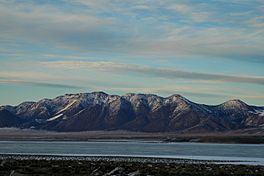Crowley Lake facts for kids
Quick facts for kids Crowley Lake |
|
|---|---|
 |
|
| Location | Mono County, California |
| Coordinates | 37°37′2.46″N 118°44′22.92″W / 37.6173500°N 118.7397000°W |
| Lake type | reservoir |
| Primary inflows | Owens River |
| Primary outflows | Owens River |
| Basin countries | United States |
| Built | 1941 |
| Max. length | 12 mi (19 km) |
| Max. width | 5 mi (8.0 km) at widest point |
| Surface area | 5,300 acres (21 km2) |
| Average depth | 40 ft (12 m) |
| Max. depth | 100 ft (30 m) |
| Shore length1 | 45 mi (72 km) |
| Surface elevation | 6,781 ft (2,067 m) |
| 1 Shore length is not a well-defined measure. | |
Crowley Lake is a large reservoir (a human-made lake) located in Mono County, California. It sits on the upper part of the Owens River. This lake is about 15 mi (24 km) south of Mammoth Lakes.
The lake was created in 1941. It was formed when the Long Valley Dam was built by the Los Angeles Department of Water and Power (DWP). The main reasons for building the dam were to store water for the Los Angeles Aqueduct and to help control floods. The dam is 126 ft (38 m) tall. It holds a huge amount of water, about 183,465 acre⋅ft (0.226301 km3).
Contents
Fishing at Crowley Lake
Crowley Lake is very famous for its amazing trout fishing. Many people, sometimes between 6,000 and 10,000 anglers, visit the lake on opening day. The biggest brown trout ever caught here weighed 26 lb (12 kg)!
People from all over California come to Crowley Lake. They especially enjoy fly fishing in late summer and fall. This is because the lake has some of the largest trout around.
Visiting the Fish Camp
To get onto the lake, you need to go through the Crowley Lake Fish Camp. This camp works with the Los Angeles Department of Water and Power. At the Fish Camp, visitors can rent boats. You can also book a camping spot there. Plus, you can buy supplies for your fishing trip.
Who Was Father John J. Crowley?
The lake is named after a special person, Father John J. Crowley. People called him "the desert Padre." He was a very important figure in the history of the Owens Valley. He was seen as a local hero.
When the city of Los Angeles started taking water from the Owens Valley, farming became very difficult. Many people living in the Valley felt like they had lost everything. Father Crowley traveled throughout the Valley. He encouraged people to believe that the area could become a great place for tourists.
So, even though Crowley Lake helps provide water for Los Angeles, it's also a top spot for fishing. This makes the name very fitting. Father Crowley sadly passed away in 1940 in a car accident.
Mysterious Columns of Crowley Lake
After the reservoir was finished in 1941, some strange rock formations appeared. These were seen along the eastern shore of the lake. They looked like tall columns, with some reaching up to 20 ft (6.1 m) high.
At first, people thought they were just odd rocks. Some described them as stone cylinders. They seemed to be connected by strong stone arches. It looked like they had been hidden for millions of years. The lake's strong waves slowly wore away the softer rock around them. This revealed the pillars underneath.
How the Columns Formed
For a long time, these pillars were just a mystery. Then, in 2015, geologists finally understood them. They realized the columns were formed in a unique way. Cold water from melting snow seeped into hot volcanic ash. This ash was left from a huge volcanic eruption. That eruption happened over 760,000 years ago at the Long Valley Caldera.
When the cold water hit the hot ash, it created tiny holes. This process also made boiling water and steam. The steam then rose up through these same holes. Scientists studied samples of these formations. They found that tiny cracks in these "convection pipes" were sealed by minerals. These minerals were strong enough to resist the lake's waves.
Researchers have now found almost 5,000 of these pillars. They appear in groups and come in many shapes, sizes, and colors. They cover an area of 4,000 acres (16 km2). Some columns stand straight up like tall poles. They even have ring-like openings about a foot apart. Others are bent or leaning. Some are partly underwater. People say these look like the fossilized bones of dinosaurs!
Images for kids




